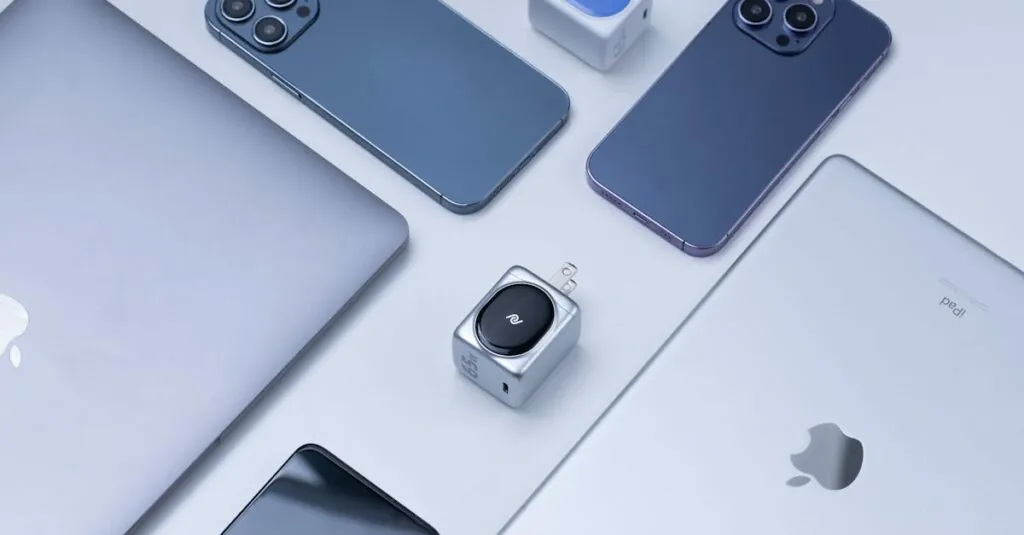Table of Contents
ToggleIn a world where sharing is caring, the iPhone 14 steps up to the plate—sort of. Imagine this: you’re out with friends, and their phone is gasping for battery life like a fish out of water. You whip out your sleek iPhone 14, ready to save the day. But can it really charge other phones? Spoiler alert: it’s not quite a superhero in that department.
Overview of iPhone 14’s Charging Capabilities
The iPhone 14 lacks the ability to charge other phones. Users looking for a device that shares battery power may find disappointment.
Wireless Charging Features
Apple designed the iPhone 14 to support MagSafe wireless charging. This allows it to connect with MagSafe accessories easily. Users enjoy a maximum charging speed of 15 watts with compatible MagSafe chargers. Standard Qi wireless chargers also work, but the speed drops to 7.5 watts. Any device compatible with these charging methods benefits from this seamless experience. While it excels at charging its accessories wirelessly, it doesn’t extend that capability to other phones.
Wired Charging Options
The iPhone 14 features a Lightning connector for wired charging. This connector supports fast charging, allowing users to reach 50% battery in about 30 minutes with a 20-watt adapter or higher. It’s compatible with USB-C to Lightning cables, enhancing convenience. Devices supporting USB Power Delivery can achieve higher charging speeds. Users appreciate the reliability of wired charging, but it remains limited to iPhone 14 and compatible devices only. Sharing battery power with other smartphones doesn’t fit into its wired capabilities.
Can iPhone 14 Charge Other Phones?
The iPhone 14 lacks the capability to charge other smartphones. Users might find this important if they expect to share battery power in emergency situations.
Compatibility with Other Devices
The iPhone 14 does not support charging for devices outside its brand. MagSafe accessories offer compatibility for charging iPhones and AirPods but not for other manufacturers. Qi charging remains limited to compatible devices, further restricting charging options. It remains essential to carry portable chargers for charging needs.
Limitations and Considerations
Several limitations restrict the iPhone 14’s battery-sharing functionalities. It doesn’t support reverse wireless charging, which some competing models provide. Battery health can diminish over time with excessive use of charging features. Users should consider that sharing power is not feasible, whether in person or through accessories. Charging other phones isn’t an option, and relying solely on the iPhone 14 for this purpose isn’t advisable.
How to Use iPhone 14 for Charging Other Phones
The iPhone 14 is not equipped for charging other smartphones directly. It lacks reverse wireless charging, a feature found in some competitor models.
Step-by-Step Guide
- Connect your iPhone 14 to a power source using the included Lightning cable.
- Find a compatible device that needs charging. This includes devices that support MagSafe or Qi.
- Place the compatible device on any Qi charging pad. Ensure proper alignment for effective charging.
- Monitor charging status on the compatible device to ensure it receives power.
Tips for Optimal Charging
Use only MagSafe or certified Qi accessories for best results. Maintain iPhone 14’s battery health by avoiding excessive accessory usage. Charge the iPhone 14 fully before attempting to use it for charging others. Keep the devices aligned properly to maximize efficiency. Regularly check compatibility of accessories to ensure optimal performance.
Comparison with Other Smartphone Charging Features
The iPhone 14’s charging capabilities stand out when contrasted with other smartphones.
iPhone 14 vs. Competitors
Many flagship models include reverse wireless charging, a feature absent in the iPhone 14. Samsung’s Galaxy S21 and later versions allow users to power other devices directly. Google’s Pixel series also supports reverse charging, facilitating quick access to battery life for accessories. Despite lacking this feature, the iPhone 14 excels in fast wired and wireless charging options. It uses MagSafe technology to provide 15-watt charging speeds with compatible accessories, which is competitive compared to the 7.5-watt speeds typical of Qi chargers. Therefore, some users may find the charging performance of the iPhone 14 impressive, although it does not offer the cross-device compatibility some competitors provide.
Advantages and Disadvantages
The iPhone 14 includes several advantages related to charging. Fast charging capabilities enable the iPhone 14 to reach 50% battery in about 30 minutes with the right adapter. Additionally, MagSafe accessories enhance convenience for users, adding a magnetic element for simple alignment. However, limitations arise due to its inability to charge non-Apple devices. Without reverse wireless charging, users seeking shared power options may be disappointed. Battery health concerns also develop with excessive use of charging features, indicating a balance between convenience and longevity. Ultimately, carrying portable power banks offers a reliable solution for users needing extra charges.
The iPhone 14 offers impressive charging capabilities for its own devices but does not extend this feature to other smartphones. While it excels in fast charging and supports MagSafe accessories, users looking to share power with friends or non-Apple devices will find it lacking.
For those who often find themselves in need of extra battery life for their devices, investing in a portable charger is a smart choice. This ensures that power is always available when needed, without relying on the iPhone 14’s limitations. Overall, understanding these features can help users make informed decisions about their charging needs.





